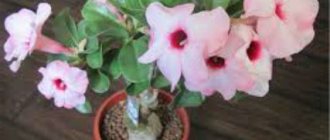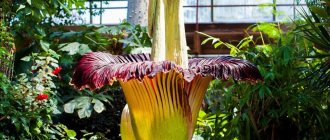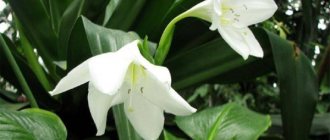Haworthia Cooper (Trunkata)
This amazing succulent evokes associations with science fiction films: the tips of its leaves are transparent, so the plant resembles a bunch of bubbles.
- Haworthia is undemanding in care.
- She loves the light that she absorbs through transparent “windows”, but is afraid of direct sunlight.
- The succulent can be placed on a windowsill, nightstand, or hung on a wall holder.
- In hot weather, you should water your haworthia once a week, and in winter - once a month.
Exotic tropical indoor flowers
Indoor flowers and flowering plants with names
This class includes the so-called exotics:
- Guzmania;
- dope;
- orchid;
- passionflower.
Guzmania
Some gardeners call the culture guzmania, and it belongs to the Bromeliad family. The flower is found in Brazil, Venezuela, Florida, and the West Indies.
The peculiarity of Guzmania is that flowers appear once in a lifetime. Some plant lovers have to wait several years for flowers to appear on the bush. If there are children, they are replanted, but the parent bush still faces death.
Datura
The homeland of the poisonous flower is in the tropics and subtropics. In cool climate regions it is grown as an annual crop. Despite the danger that dope poses to humans, it is used for medicinal purposes. When handled correctly, a flower can become the highlight of a presentation.
Datura flowering
The beauty of the buds is admired after the sun sets or in cloudy weather, since the flower is nocturnal.
Orchids
All lovers of indoor plants are familiar with this exotic representative. Each variety of orchid is unique and original. Before you start breeding such a crop, you should decide on the variety and find all the information about it. There are a huge number of nuances, without knowledge of which it is easy to ruin a tropical beauty.
Passionflower
Luxurious flowers and unpretentious appearance are all about passionflower. The culture has tasty fruits with medicinal properties. The more famous name for the delicacy is passion fruit.
passionflower flower
There are several varieties of crops that can be successfully grown at home:
- blue;
- edible;
- incarnate;
- royal star;
- maestro;
- gigantic.
Dischidia Raffles
A plant of the root-climbing family, which has a strange appearance and resembles a vine. Its peculiarity is that the leaves have an unusual shape: on the first level they are fleshy, and on the second they are large and bag-like. Under natural conditions, leaves accumulate rainwater. The length of dischidia can reach 5 meters.
Requires plenty of diffused light, temperatures from 18 to 30 degrees and high humidity. That is why flower growers prefer to grow dischidia in a florarium.
The rarest indoor flowers
Indoor plants and beautiful home flowers
It is worth considering the rarest home flowers grown in apartment conditions.
Pseudolithos
It is a succulent plant and belongs to the Lastovnevye family. If you translate the name of the exotic into Russian, it will sound like “false” or “fake stone”.
Pseudolithos has no leaf blades. The shoots are typically woven into a ball. Edges appear on the surface. The skin of the shoots can be brown-green, olive or grayish. Pinkish and silvery varieties are also found.
False stone
During flowering, the plant is pollinated by flies. Exotic indoor flowers have a peculiar smell similar to rotting meat. “False stone” blooms from late summer until November.
Dischidia rafflesiana
Australia, India, Polynesia and their tropical forests are habitat areas of the spreading vine. The culture is nourished by the juices of the plants to which it is attached. Today, more than a hundred varieties of vines are known, but you can only grow them as a houseplant:
- dyschidia ovata;
- dischidia russifolia;
- dischidia pectinata;
- dischidia vidalia;
- Raffles dischidia.
Trichocaulon
The culture has a spherical or cylindrical stem. It may be light green, brown or bluish. The formation of flowers occurs at the top of the stem, the petals are round or pointed.
The plant is characterized by endurance in extreme heat (spring and summer months). With the onset of autumn, the green pet is moved to a room with a temperature of +12 ° C so that the trichocaulon begins a period of rest. An exotic flower needs it.
Trichocaulon
Trachyandra or Trachyandra (Trachyandra)
The plant is a perennial, and it is interesting because the leaves are curls of a dark green color. The unusual shape of the leaves makes the crop relevant for home cultivation.
Important! Excessive watering is detrimental to this plant. Excess moisture causes leaves to lose their ability to form curls.
Before buying unusual indoor flowers, it is worth remembering that the plant will need specific care, otherwise it will be easy to ruin the plant.
Crassula Wine Cup (Umbella)
This succulent is a relative of the common Crassula. Due to its unusual shape, Crassula is called the Wine Cup or Bowl.
- It is unpretentious, easily tolerates both bright light and shade, and can grow in dry soil for a long time, so it is excellent for growing by novice gardeners.
- Loves fresh air - you can take it out to the balcony.
Wine Cup juice is used for medicinal purposes, but should not be taken orally due to its high concentration of arsenic!
Hypoestes
All types of hypoestes are surprisingly decorative. This Madagascar guest in our homes can have very different leaf colors: from almost white to a combination of dark burgundy and green.
The plant has a long flowering period. From June to December, small panicles of inflorescences periodically appear, which are lost against the background of bright foliage.
Hypoestes is unpretentious. The only requirement that the flower makes to its owners is bright lighting . He will tolerate the rest of the inattention to his person.
Mimosa bashful
You can occasionally surprise guests with this plant by lightly touching it: the mimosa curls up its leaves from any external irritants. In South Africa it is an evergreen shrub.
Do not keep in a house where animals live: mimosa leaves cause poisoning!
- In the spring-autumn period it grows well at a temperature of 20–24 degrees, and in winter – at 16–18.
- Tolerates even direct sunlight.
- In hot weather, it requires abundant and regular watering in the summer, and in the cold season, slightly moist soil is sufficient.
- It blooms with graceful spherical flowers of a soft lilac color.
- Due to tobacco smoke, it drops its leaves.
Top expensive indoor plants 2022: selection by Elena Kostrova
Monstera deliciosa Mint - cost from $3,000 per cutting with one leaf.
Monstera deliciosa Mint
Monstera Oblique Peru - from $2000; one cutting - 40 thousand rubles, from 23 thousand rubles. per node without leaves.
Monstera Oblique Peru
Separate varieties of neophynetias of Japanese and Korean selection - $500-10,000 for a young plant that has not reached flowering age.
Neofinetia, neofinetia falcata Benkeimaru Shima
Variegated haworthia varieties of Japanese selection: the price tag for them is from $500 to $5000. Collectors have rare Haworthia maughanii variegata $4.5 thousand 3-4 leaves; Haworthia comptoniana variegata and Haworthia koelmaniorum variegata. They grow extremely slowly and reproduce poorly. When propagated by culture, tissues often lose their variegation, which is why the price tag for these plants is appropriate. True, Chinese clones can cost several times less, but they behave unpredictably and sometimes do not maintain variegation and turn green. In addition, cheap planting material has practically stopped the progress in the expensive and multi-year selection of haworthias.
Haworthia, haworthia truncata - variegated varieties
Philodendron Caramel Marble - from $3000 per plant with 1-2 leaves with well-defined variegation, I have $250-300 on pre-order. Indeed, a beautiful variety with dissected leaves and multi-colored variegation.
Philodendron, philodendron Caramel Marble
Philodendron Joepii is an extremely rare philodendron. Named after the French naturalist Joep Moonen, who discovered the plant at the mouth of the Mataroni River in eastern Guiana. The length of an adult leaf is up to 70 cm. Philodendron has not yet undergone the procedure for officially registering the name of the species, $175 rooted cuttings.
Syngonium Strawberry Ice - $75 per cutting. This is a spectacular, valuable variety: on a green background there is a random mosaic of bright pink, cream spots and strokes.
Sissy
The fern thickets look amazing: it seems that dinosaurs are about to emerge from them, hiding in the damp coolness. Indeed, ferns lived well next to these animals, providing them with shelter and food.
The green foliage that people love them for is not actually leaves in the traditional sense. In ferns, this structure is called a frond, has the same color and performs the same functions as in other plants. But there are also serious differences: it is on the fronds that fern spores develop, that is, these modified shoots simultaneously breathe and hold spores, like flowers.
But this is not even the most amazing thing about ferns. The adiantum thin-leaved species has very fragile and thin foliage. It is often used during practical classes in universities during lessons on plant anatomy, because each leaf consists of exactly one layer of photosynthetic cells. The size of these cells is quite impressive for the plant world, and under a microscope, all organelles in each cell are clearly visible. Looking at the adiantum, you can easily form an opinion about the thickness of one plant cell. The main thing is to be very careful with the fern so as not to damage the teaching aid. In nature, there are no leaves thinner than those of adiantum thin-leaved.
Calathea
Also comes in hundreds of colors. In many types of calathea, the color of the leaves above and below is different, which gives it a special charm. It blooms rarely, but with bright inflorescences.
During the season, each plant throws out 5-6 new large leaves, so it grows quite quickly, but only with proper care - this beauty is capricious .
It requires a warm, shaded place with a constant air temperature, humidity of 80–90%, and frequent showers. With poor care, it is affected by fungal diseases, which are difficult to cope with.











